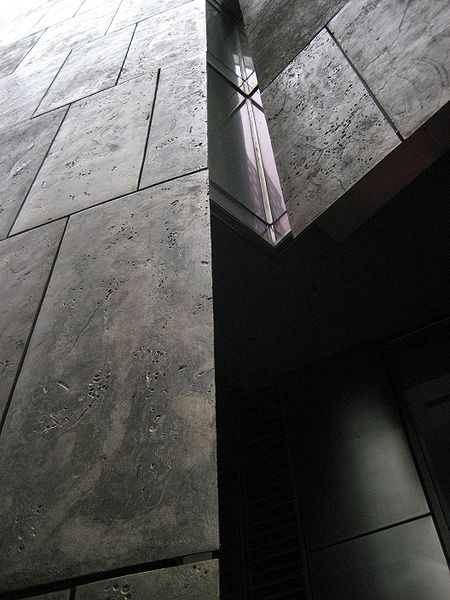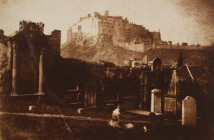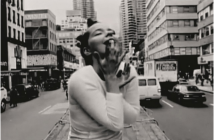In real estate, location counts. This importance, of the site on which a building stands and the neighbors it abuts, has never been lost on the art institutions of Manhattan. Henry Clay Frick started collecting art in his Fifth Avenue villa and there it remained after his private home was converted into a public gallery. The Whitney is planning a move from its landmark building on the Upper East Side to a new Renzo Piano creation sited at the entrance to the city’s favorite new park-cum-art space, The High Line. These examples indicate the adaptive nature of some museum settings and the striking fluidity with which these large institutions can evolve to suit the changing topographies of contemporary culture.
The American Folk Art Museum constructed its humble galleries in 2001 next door to the Museum of Modern Art, which was in the process of a major renovation that was eventually completed in 2004. This location was clearly advantageous for the comparatively small, lesser-known Folk Art Museum and the prime midtown spot seemed worth the expense of building an entire museum from scratch. In 2011, just 10 years after it first opened the new galleries, the Folk Art Museum vacated the space and eventually sold it to the Modern in order to pay off debts.
The Folk Art Museum, though miniature by New York’s standards, is significant in its own way. It is visually striking, especially so next to the bleak glass expanse that is the Modern. A multifaceted bronze façade has the appeal of a handmade object and properly reflects the rustic nature of many of the artworks once displayed within its walls. The interior was not designed on a grand scale like many of its peer institutions, but mimicked the approachability of the works it celebrated. In comparison to its neighbor, the Folk Art Museum building is far less dogmatic and far more subjective. Unapologetically warm, the museum lacks the air of pomp possessed by the Modern and is comparatively more welcoming. These stark differences in the respective styles and personalities of the neighbor museums are a fact that will likely cause the destruction of the former Folk Art Museum.
The Museum of Modern Art recently declared it will take down the structure, citing the fact that the vacant space could not be easily adapted to its needs and noting that the bronze façade of the vacant museum does not match the cool glass austerity of its own building. The Folk Art Museum was also designed for a smaller audience and would most likely not be practical for the throngs of visitors the Modern hosts on a daily basis. The plan to demolish a work that won awards for its designers Tod Williams and Billie Tsien is in itself odd, but this same destruction at the hands of the administrators of the Modern, who are often considered to be the conservators of such treasures is surprising and has inspired backlash.
 Photo used under the Creative Commons License, Wikimedia user Sam iv
Photo used under the Creative Commons License, Wikimedia user Sam ivThe early critics of the Modern’s plan are protesting the proposed demolition of a building New Yorkers have barely even gotten to know. Architectural Record’s Cathleen McGuigan shared a fantastically acerbic editorial tracing the lineage of MoMA’s treachery. Paul Goldberger of Vanity Fair penned an impressive examination of the faults in the reasoning behind the proposed demolition, calling it "architecture-cide." A Twitter account has also been set up at the handle @FolkMoMA to suggest ideas for creative uses that would save the empty museum.
The salvation of the building seems unlikely as the Modern appears to be bent on expanding in a way they deem to be cohesive, which will likely include more glass and white paint. It is worrying to see the bastion of the avant-garde turn on a structure because it would promote heterogeneity within the Modern’s campus. Their quest to demolish a structure rather than adapt it to their needs due to location and style is not surprising in the context of Manhattan’s history, though.
The scene revives memories of the 1963 demolition of Pennsylvania Station. The railroad-owner of the landmark needed cash and worked with developers to offload the air rights to the famed station, whose location over a major commuter hub seemed the perfect place to put a destination arena: Madison Square Garden. The destruction of the neoclassical monument to transportation, which was a little more than 50 years old at the time, caused a storm of controversy and led to the beginning of the preservationist movement. The promise before the demolition then was a sleek modernized station located conveniently in the basement of the new Garden. This would serve as a replacement for the outdated precursor and provide a modern entrance to a modern city. Today, in light of a decaying complex above and outmoded station below, the city is considering limiting the special permit the Garden needs to continue, raising hopes that the station could someday be renovated and made to feel more humane and less like an air raid shelter.
This digression forms a necessary comparison, not because the Folk Art Museum is of the same caliber as the original Pennsylvania Station, but because it illuminates the fact that where a building is located can place in squarely in the path of the wrecking ball. If its demise does come like the Modern is promising, the disappearance of the Folk Art Museum will not likely cause a seismic shift in the way people evaluate the worth of buildings like the loss of Penn Station did. It will, however, certainly leave the same bad taste in everyone’s mouths and a lingering sadness for those who knew and loved it while it lasted.




